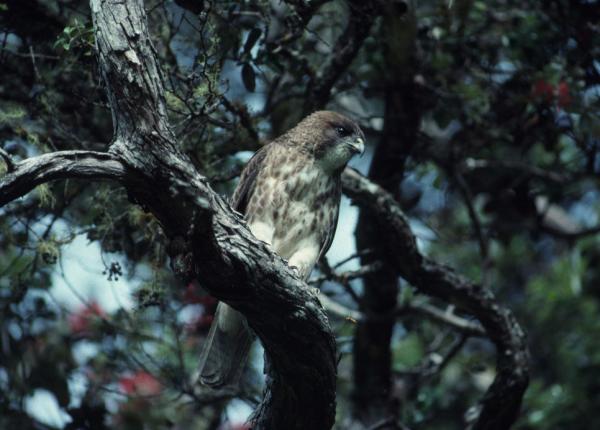Did You Know?
- This hawk is Hawaii's only resident hawk
- In Hawaii, this hawk is called 'Io
- Like other Buteos, the Hawaiian Hawk presents in both light and dark morph color phases
- Of all other members of the genus Buteo, the Hawaiian Hawk exhibits the most pronounced size difference between the females and their smaller male counterparts.
How The Peregrine Fund is Helping
Though The Peregrine Fund doesn't work directly with Red-tailed Hawks, our efforts in scientific research, habitat conservation, education, and community development help conserve raptors on a global scale. We also supply literature to researchers from our avian research library, which helps scientists around the world gather and share important information on raptor conservation. We also support the Global Raptor Impact Network, which gives raptor researchers tools to more efficiently conduct their own studies while contributing to a global program. GRIN also provides citizen scientists a way to participate in raptor science and conservation.
Where They Live
As its name implies, the Hawaiian Hawk is endemic to Hawaii. This means it is found there and nowhere else on Earth. It makes its home in a number of different habitat types, including native and exotic habitats. It can be found in mature native forest, along edge habitat, and even in areas with introduced grasses.
Why They Need our Help
The Hawaiian Hawk is classified as Near Threatened by the IUCN. Though some scientists feel the species should be downlisted, meaning its population is considered stable and thus the species is not of conservation concern, many scientists disagree with this assessment. Indeed, there are many threats this species faces including loss of habitat, human persecution, and possibly secondary poisoning after they prey on rodents that have been poisoned with rodenticides.
What They Eat
Scientists have documented this species feeding on a long list of prey items including a number of different species of birds, such as Hawaiian Crow, Chukars, Pacific Golden-Plovers, Common Mynas, Northern Cardinals, House Finches and more! It has adapted to feed upon introduced rodents, and has even been documented feeding on the introduced Indian Mongoose! It is also known to feed on invertebrates including cockroaches, caterpillars, moths, dragonflies, and crayfish.
Nests, Eggs, and Young
The Hawaiian Hawk builds bulky nest structures composed of large sticks, which they place in trees. Both the male and the female work together to build the nest. Once the time is right, the female will lay one to two eggs, though a clutch of one egg is most common. The egg is pale bluish- or greenish-white when laid and it must be incubated for around 38 days before the young will hatch.e
After the nestling hatches, the female will brood her young for several weeks. This means she stays in the nest, covering her nestling to help keep it safe and at just the right temperature. During this time, the male works hard to catch food for himself, the female, and his young. Though there is still a lot to learn about the nesting habits of the Hawaiian Hawk, biologists believe that the young stay in the nest for around 60 days. Even after the young hawk is an agile flyer, it will stay with the adults learning to hunt and avoid danger for several more months.
Hawaiian Hawk and the World Center for Birds of Prey
The World Center for Birds of Prey offers fun ways to learn about birds of prey. Interactive activities, tours, interesting videos and a children's room with activities from coloring sheets to quizzes to costumes await you on your visit. Though we don't have any Hawaiian Hawks on our Avian Ambassadors team, you can meet a few live hawks up close including a Red-tailed Hawk and a Swainson's Hawk. There is also a touch table with owl feathers and other natural objects available for exploration.
References:
Clarkson, K. E. and L. P. Laniawe (2020). Hawaiian Hawk (Buteo solitarius), version 1.0. In Birds of the World (A. F. Poole and F. B. Gill, Editors). Cornell Lab of Ornithology, Ithaca, NY, USA. https://doi.org/10.2173/bow.hawhaw.01
Global Raptor Information Network. 2022. Species account: Hawaiian Hawk Buteo solitarius. Downloaded from http://www.globalraptors.org on 29 Mar. 2022










